Abstract
Let Heff (Veff, Eeff) be a finite simple connected graph of order m with vertex set Veff and edge set Eeff. A dominating set is called an efficiently dominating set if, for every vertex —where NG [ua] denotes the closed neighborhood of the vertex ua. Using efficient domination techniques and labelling, we constructed the fuzzy network. An algorithm has been framed to encrypt and decrypt the secret information present in the network, and furthermore, the algorithm has been given in pseudocode. The mathematical modelling of a strong fuzzy network is defined and constructed to elude the burgeoning intruder. Using the study of the efficient domination of fuzzy graphs, this domination parameter plays a nuanced role in encrypting and decrypting the framed network. One of the main purposes of fuzzy networks is encryption, so one of our contributions to this research is to build a novel combinatorial technique to encrypt and decode the built-in fuzzy network with a secret number utilizing effective domination. An illustration with an appropriate secret message is provided along with the encryption and decryption algorithms. Furthermore, we continued this study in intuitionistic fuzzy networks.
MSC:
05C72; 05Cxx; 68R10
1. Introduction
The link between lines and points is described by a graph, which is a mathematical representation of a network. A graph is composed of some points and their connecting lines. Labelling is a tool for counting the people (nodes) and the relationships (links) that exist between any two members. This helps to identify the set of significant individuals who play a vital role in the given network. The secret information will be developed in the network using the encryption technique and decoded using the decryption process. In order to prevent unwanted parties from reading a communication, it must first be transformed from a readable form into an unreadable one through the process of encryption. Decryption is the process of returning an encrypted message to its original (readable) format. To develop this role in the network graphs, network graphs are used to depict and study the relationships between entities. An entity may be a person, an event, a transaction, a vehicle, or anything else. The relationships between entities are shown as lines called links, while the entities themselves are shown as nodes. As we have network graphs, the domination concept is used to identify the effective node to monitor the network.
Hence, domination plays a vital role in the decision making, monitoring, an minimizing the cost of the network, etc. Let ‘O’ denote the set of monitoring members (a set of nodes) of the given network. Every member in the given network except the monitoring members should be the neighbor of at least one monitoring member of the given network. The minimum number of monitoring members of this network is the domination number of the given network. Every member in the given network except the monitoring members should be a neighbor of exactly one monitoring member of the given network. The minimum number of monitoring members of this network is the efficient domination number of the given network. Even though the given secret information is a non-zero integer, while using fuzzy graphs, it has been converted to a non-integer by some combinatorial technique.
Zadeh proposed a mathematical framework to characterize the phenomenon of uncertainty in real-world situations in 1965 [1]. The idea of fuzzy graphs and various fuzzy analogues of graph theory ideas with connectedness were first introduced. Bondy and U.S.R. Murthy [2] introduced graph theory and its applications. Ore [3] and Berge started researching graphs’ domination sets. Paired domination studies were initiated by Teresa W. Haynes and Slater P. J. [4]. Biggs [5] and Kulli [6] wrote the theory of domination in graphs. Kulli and Janakiram [7] were the first to investigate split domination in graphs, and Kulli et al. [8] studied the total efficient domination in graphs. The independent domination number was first used in graphs by Cockayne and Hedetniemi [9]. Equitable domination was introduced by Swaminathan and Dharmalingam [10]. Paired equitable domination was introduced and studied by Meenakshi and Baskar Babujee [11], and it continued in an inflated graph and its complement of a graph [12]. Kwon et al. [13] studied the classification of efficiently dominating sets of circulant graphs of a degree of 5.
Somasundram and Somasundram [14] initiated the studies of domination and total domination in fuzzy graphs. Nagoorgani and Chandrasekaran [15] instigated the domination in fuzzy graphs using strong arcs. Domination in fuzzy directed graphs was proposed by Enrico Enriquez [16]. Intuitionistic fuzzy relations and intuitionistic fuzzy graphs (IFGs) were developed by Atanassov [17]. IFG was defined by Karunambigai et. al. [18], which is a special case of IFGs defined by Shannon and Atanassov of [19]. The terms “order,” “degree,” and “size” of IFG were defined by Nagoor Gani and Shajitha Begum [20]. Split domination in intuitionistic fuzzy graphs was introduced by Nagoor Gani and Anu Priya [21]. Split domination in the neutrosophic graph was studied by Mullai et al. [22]. Meenakshi and Baskar Babujee [23] studied encryption through labeling using efficient domination, and it has been generalized in [24]. The research work presented in [23,24] is extended to fuzzy graphs and intuitionistic fuzzy graphs.
Our contributions in this research work seek to establish the new combinatorial technique to encrypt and decrypt the constructed fuzzy network with a secret number using efficient domination, which is one of the main applications of fuzzy networks. Furthermore, we constructed a strong intuitionistic fuzzy network using the same concept defined in a strong fuzzy network. Along with the encryption and decryption algorithms, an illustration has been given for both cases with a suitable secret message.
2. Preliminaries
Definition 1.
A fuzzy graph (FG) is of the form which is a pair of functions ; where for
Definition 2.
The underlying graph of a fuzzy graph (FG) is of the form HFG * = (VF, EF) where VF = and EF =
Definition 3.
A subset TF of VF is said to be the dominating set of a fuzzy graph if, for every vertex in VF − TF, is dominated by at least one vertex of VF. The dominating set TF is said to be minimal if no proper subset of TF is a dominating set.
Definition 4.
An arc is said to be a strong arc if its degree of edge membership value is equal to the strength of connectedness between u and v.
Definition 5.
Let e = () be an edge of a fuzzy graph. We say that dominates if there exists a strong arc between them.
Definition 6.
Let HG (VG, EG) be a finite simple connected graph of order m with vertex set VG and edge set EG. A dominating set is called an efficiently dominating set if for every vertex —where NG [ua] denotes the closed neighborhood of the vertex ua.
3. Efficient Domination in Fuzzy Graph
Definition 7.
Fuzzy network (FN) is defined as a group of the same category peoples (a set of nodes) which interact with each other and work together (the link is a relation which represents the sharing work or sharing information) such that every node (person) has a degree membership of value. The relation (information, knowledge sharing, etc.) between any two persons is represented by link. The link also has a degree of membership value.
Definition 8.
A network is said to be a fuzzy network if it satisfies for every
Definition 9.
A fuzzy network is said to be strong if it satisfies for every
Definition 10.
A dominating set TF of VF is said to be an efficiently dominating set of a fuzzy graph if for every vertex in VF − TF, where N[] represents the closed neighborhood of . The dominating set TF is said to be minimally efficiently dominating if no proper subset of TF is efficiently dominating. The following fuzzy network FN is strong.
Example
Every edge in the fuzzy graph in Figure 1 is strong, and the only efficiently dominating set is TF = {a, d} since every vertex in VF − TF is dominated by exactly one vertex and this dominating set is unique.
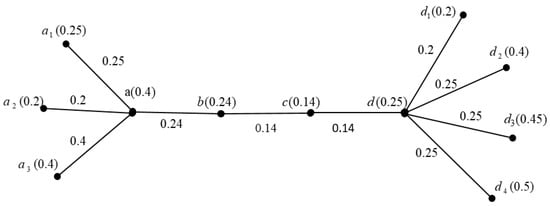
Figure 1.
Strong fuzzy network.
4. Encryption and Decryption of Fuzzy Network Using Efficient Domination
This main framework of this paper consists of:
- (a)
- The construction of SFN from sub-SFN, where SFN is a strong fuzzy network;
- (b)
- Secret key generation;
- (c)
- An encryption algorithm;
- (d)
- A decryption algorithm.
4.1. Construction of SFN from Sub-SFN
The secret number (numerical value) to be encrypted is a positive integer which is not zero. Select the suitable numerical value . Now, NuVa is subdivided into ‘r’ values, say , , …, such that (where R1 = 0), (where R2 = 1), (where R3 = 2), …, (where Rr = rm−1). Since we have ‘r’ subdivision values, we have to frame the ‘r’ subnetwork and plan to assign ‘r’ efficient domination nodes in the constructed network. Let the efficiently dominating nodes (EDNs) be o1, o2, o3, …, or. These nodes are the center of the subnetworks, say SFN1, SFN2, SFN3, …, SFNr, respectively. Let the neighbors of o1, o2, o3, …, or be ; ;,…., respectively.
The first SFN subnetwork is SFN1, whose center is o1 and its neighbors are .. The first subdivision value . Set and (where is the numerical value 1 followed by the number of 0 digits of the integral part of V1) partitioned into the sum of l1 values, say , respectively, and assign these values a minimum value of either o1 or , and a degree of edge membership value, which is shown in Figure 2.
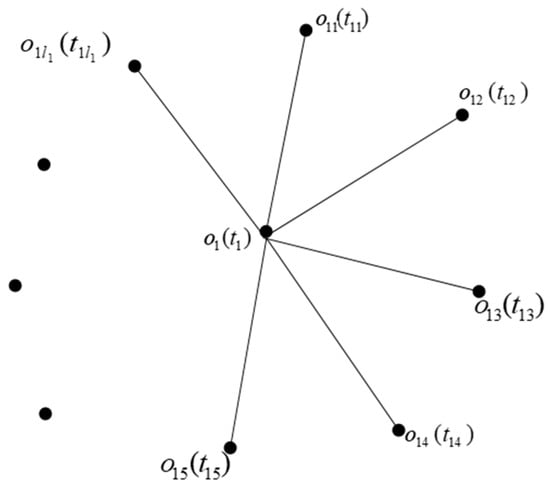
Figure 2.
SFN subnetwork-1.
The second SFN subnetwork is SFN2 (Figure 3), whose center is o2 and its neighbors are The first subdivision value . Set and (where is the numerical value 1 followed by the number of 0 digits of integral part of V2) partitioned into the sum of l2 values, say , and assign these values a minimum value of either o2 or , as a degree of truth membership value. Repeat the process until the subnetwork SFNr is framed (Figure 4).
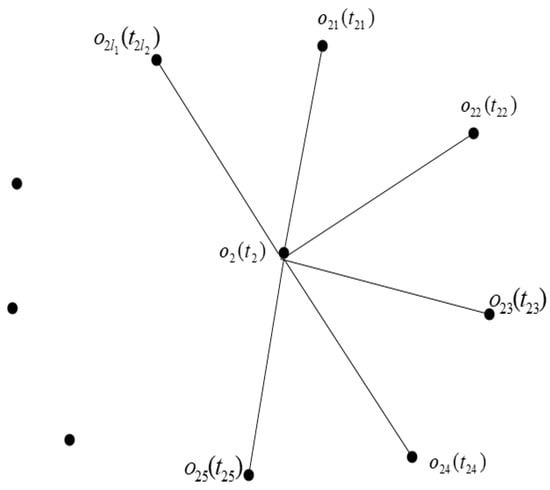
Figure 3.
SFN subnetwork-2.
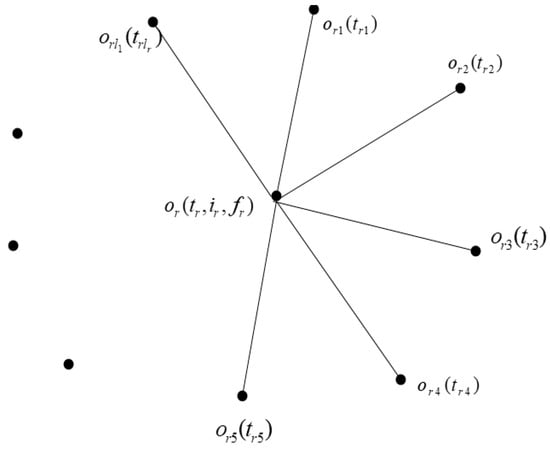
Figure 4.
SFN -rth subnetwork.
By the definition of SFN, the degree of membership values of the edges are min{, min{, …, min {, respectively.
By the definition of SFN, the degree of membership values of the edges are the min, min{, …, min{ respectively. Repeat the process until framing the subnetwork SFNr and by the definition of FSN, the rest of the edge’s degree membership values will be defined.
By the definition of SFN, the degree of membership values of the edges are min{, min{, …, min{, respectively.
4.2. Secret Key
The key is to break the encrypted SFN into the efficiently dominating set of the SFN encrypted network. Once we find the efficiently dominating set of this SFN network, we can decrypt it.
4.3. Encryption Algorithm
Input: , as the secret number;
Output: encrypted SFN network;
Step 1.
Subdivide the secret number into “r” values , , …, such that (where R1 = 0), (where R2 = 1), (where R3 = 2), …, (where Rr = rm − 1).
Step 2.
Frame the ‘r’ subnetwork and assign the ‘r’ efficient domination nodes in the constructed network. The efficiently dominating nodes (EDN) are o1, o2, o3, …, or. These nodes are the centers of the subnetworks say SFN1, SFN2, SFN3, …, SFNr, respectively. The neighbors of o1, o2, o3,…, or are ; ; ,…., respectively (conveniently choose the number of neighboring vertices of o1, o2,o3,…, or, respectively, where .
Step 3.
The number of nodes present in the SFN network is . Define Min E (minimum no. of edges present in the constructed network denoted by Min E) I only one where Hence, the minimum number of edges present in the network is
Step 4.
Define (maximum no. of edges present in the constructed network is denoted by Max E)MaI
Step 5.
Set , , …,
(where denotes the numerical value 1 followed by the number of 0 digits of integral part of V1);
(where denotes the numerical value 1 followed by the number of 0 digits of integral part V2), …, ;
(where denotes the numerical value 1 followed by the number of 0 digits of integral part of Vr).
Step 6.
Split ; ;….; ;
Assign , , …, in the first subnetwork.
Assign , , …, in the second subnetwork, continuing the process until assigning , , …, , in the r-th subnetwork.
Step 7.
Rest of the edge’s membership values will be followed by the definition of FSN
The pseudocode for the encryption algorithm is listed below as Algorithm 1.
| Algorithm 1: Encryption Algorithm | ||||
| function subdivide_secret_number (NuVa, rm): | ||||
| NuVa_sub = [] for i in range(rm): | ||||
| NuVa_sub.append(NuVa % (i + 1)) | ||||
| return NuVa_sub | ||||
| function construcI_networkI efficient_dominating_nodes): | ||||
| sub_networks = [] for i in range(r): | ||||
| sub_networks.append(SubNetwork(efficient_dominating_nodes[i])) | ||||
| return sub_networks | ||||
| function min_edges(sub_networks): | ||||
| min_e = set() for i in range(len(sub_networks)): | ||||
| for j in range(1, len(sub_networks[i].neighbors) + 1): | ||||
| min_e.add((sub_networks[i].center,sub_networks[i].neighbors[j − 1])) | ||||
| return min_e | ||||
| function max_edges(sub_networks): | ||||
| max_e = set() for a in range(1, total_nodes + 1): | ||||
| for b in range(1, total_nodes + 1): | ||||
| if a! = b and not aIy([a = sub_networks[i].center and b = sub_networks[i + 1].center for i in range(len(sub_networks) − 1)]): | ||||
| max_e.add((a, b)) | ||||
| return max_e | ||||
| function split_D_values(NuVa_sub): | ||||
| D_values = [] for i in range(len(NuVa_sub)): | ||||
| D_values.append(calculate_D(NuVa_sub[i])) | ||||
| return D_vaIues | ||||
| function assign_membership_values(sub_networks, D_values): | ||||
| for i in range(len(sub_networks)): | ||||
| for j in range(len(sub_networks[i].neighbors)): | ||||
| membership_value = min(sub_networks[i].center, sub_networks[i].neighbors[j]) sub_networks[i].neighbors[j].membership_value = D_values[i][j] | ||||
| # Main function NuVa_sub = subdivide_secret_number(NuVa, rm) sub_networks = construct_network(r, efficient_dominating_nodes) min_e = min_edges(sub_networks) max_e = max_edges(sub_networks) D_values = split_D_values(NuVa_sub) assign_membership_values(sub_networks, D_values) | ||||
4.4. Decryption Algorithm
Input: encrypted SFN
Output: , the secret number
Step 1:
Find the efficiently dominating memIs of SFN o1, o2, o3, …, or, such that where represent the neighbours of the vertex oi.
Step 2.
, …,
Step 3.
The pseudocode for the decryption algorithm is listed below as Algorithm 2.
| Algorithm 2: Decryption Algorithm | ||||
| function efficient_dominating_members(FSN, r): | ||||
| # Find r verticIs with nIommon neighbors dominating_members = empty array of size r for i in range(r): | ||||
| # Find efficiently dominating member oioi = find_efficient_member(FSN, dominating_members)# Add oi to the list of dominating membersdominating_members[i] = oi | ||||
| return dominating_members | ||||
| function find_efficient_member(FSN, dominating_members): | ||||
| # Find an efficiently dominating member that has no common neighbors with other members for vertex in FSN.vertices: | ||||
| if vertex not in dominating_members: | ||||
| is_efficient = check_efficiency(FSN, vertex, dominating_members)if is_efficient: | ||||
| return vertex | ||||
| return None | ||||
| function check_efficiency(FSN, vertex, dominating_members): | ||||
| # Check if the vertex is an efficiently dominating member that has no common neighbors with other members neighbors = FSN.get_neighbors(vertex) for member in dominating_members: | ||||
| member_neighbors = FSN.get_neighbors(member)common_neighbors = neighbors.intersection(member_neighbors)if len(common_neighbors) > 0: | ||||
| return False | ||||
| return FSN.is_efficient(vertex) | ||||
| function compute_values(FSN, dominating_members): | ||||
| # CompuIe the vaIs Vi for each dominating member values = empty array of size r for i in range(r): | ||||
| vertex = dominating_members[i]D_vi = compute_D(FSN.secret_number, FSN.rm, FSN.Rm[vertex])dj_values = compute_dj_values(FSN, vertex)Vi = D_vi * np.sum(dj_values)values[i] = Vi | ||||
| return values | ||||
| function compute_NuVa(rm, values): | ||||
| # Compute NuVa as rm times the sum of the Vi values NuVa = rm * np.sum(values) return NuVa | ||||
| # Main FSN = create_FSN() # create a FSN object with a secret number and network structure r = random_number dominating_members = efficient_dominating_members(FSN, r) values = compute_values(FSN, dominating_members) NuVa = compute_NuVa(FSN.rm, values) print(NuVa) | ||||
5. Illustration
The secret number is
5.1. Construction of SFN from Sub-SFN
We have to split this suitable numerical value under modulo rm = 5. Now, is subdivided into ‘five’ values, namely , , , , and , such that (where R1 = 0), (where R2 = 1), (where R3 = 2), (where R3 = 3) (where R4 = 4). Since we have ‘five’ subdivision values, we have to frame five subnetworks and plan to assign ‘five’ efficient domination nodes in the constructed network. Let the efficiently dominating nodes (EDN) be o1, o2, o3, o4, o5. These nodes are the center of the subnetworks SFN1, SFN2, SFN3, SFN4, SFN5, respectively. Let the neighbors of o1, o2, o3, and o4, o5 be ; ; ;; and , respectively.
The first subnetwork is SFN1 (Figure 5), whose center is o1 and its neighbors are . The first subdivision value . Set (where is the numerical value 1 followed by the number of 0 digits of an integral part of V1), which is partitioned into the sum of six values, say , which are assigned minimum values of either o1 or , respectively.
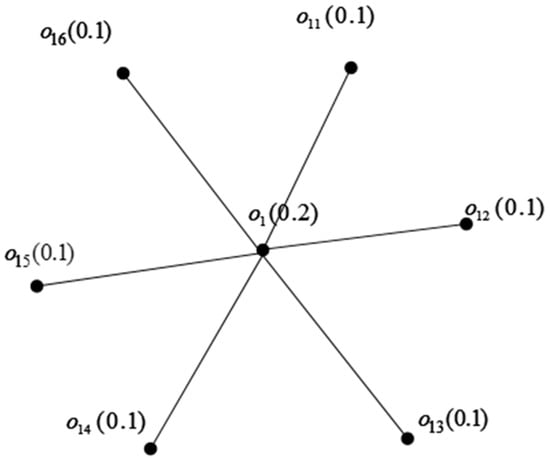
Figure 5.
Illustration of SFN subnetwork-1.
The second subnetwork is SFN2 (Figure 6) whose center is and its neighbors are . The second subdivision value . Set (where is the numerical value 1 followed by the number of 0s of integral part of V2) is partitioned into the sum of six values, namely , which are assigned minimum values of either o2 or as truth degree membership values.
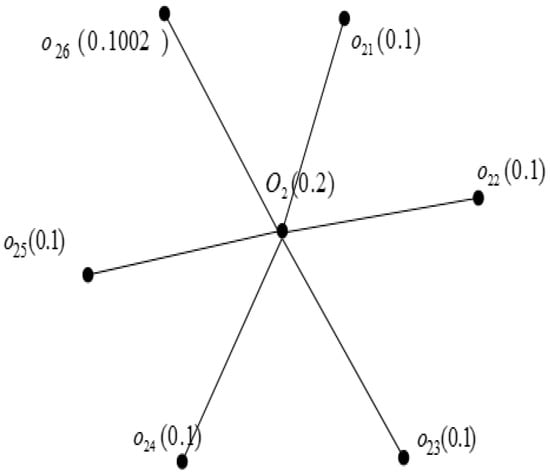
Figure 6.
Illustration the SFN subnetwork-2.
By the definition of SFN, the degree of membership values of the edges are min {, min, …, min, respectively.
By the definition of SFN, the degree of membership values of the edges are min{, min{, …, min{ r, respectively.
The third subnetwork is FSN3, whose center is o3 and its neighbors are . The third subdivision value . Set and (where is the numerical value 1 followed by the number of 0s of an integral part of V3) is partitioned into the sum of five values, say and assign these values minimum values of either o3 or as degree membership values. Construct the FSN3 subnetwork-3, similarly to the construction of subnetwork-2 in Figure 6.
Fourth subnetwork is SFN4, whose center is o4 and its neighbors are . The fourth subdivision value . Set and (where is the numerical value 1 followed by the number of 0s of an integral part of V4) is partitioned into the sum of five values, namely and assign these values minimum values of either o4 or as truth degree membership values. Construct FSN4 subnetwork-4, similarly to the construction of subnetwork-2 Figure 6.
The fifth subnetwork is SFN5, whose center is o5 and its neighbors are . The fifth subdivision value . Set and (where is the numerical value 1 followed by the number of 0s of the integral part of V5) is partitioned into the sum of six values, say , and assign these values minimum values of either o5 or , an a truth degree membership value. Construct the SFN5 subnetwork-5, similarly to in Figure 6. From all the fuzzy strong subnetworks, frame the fuzzy strong network which is shown in Figure 7.
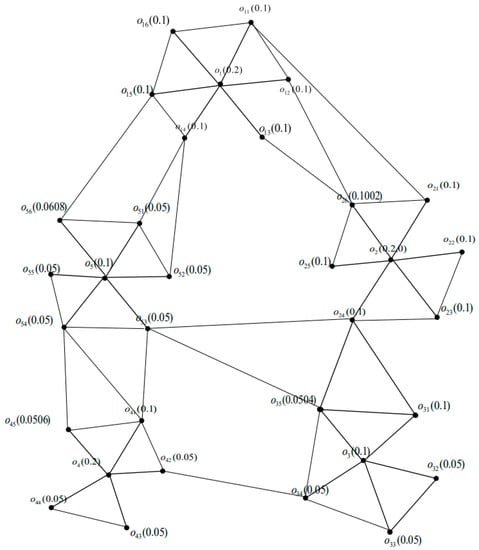
Figure 7.
Illustration of the encrypted FSN with the secret number—10,810.
5.2. Secret Key
The key is breaking the encrypted SFN is the efficiently dominating members of the SFN encrypted network, which are shown in Figure 7. Once we find the efficiently dominating set of this network, we can decrypt it. The efficiently dominating members of this SFN are o1, o2, o3, o4, and o5.
5.3. Encryption Algorithm
Input: is the secret number.
Output: encrypted FSN network (Figure 7).
Begin
Step 1.
Subdivide the secret number into ‘five’ values , , , , such that , , and .
Step 2.
Frame ‘five’ subnetworks and plan to assign ‘five’ efficient domination nodes in the constructed network. The efficiently dominating nodes (EDNs) are o1, o2, o3, o4, and o5. These nodes are the centers of the subnetworks, say SFN 1, SFN 2, SFN 3, SFN 4, and SFN 5, respectively. Let the neighbors of o1, o2, o3, o4, and o5 be ; ; ; ; , respectively.
Step 3.
The number of nodes present in the SFN network is 33.
Minimum no. of edges present in the constructed network is denoted by Min E = for only one where
Hence, the minimum number of edges present in the network is 32.
Step 4.
Maximum number of edges present in the constructed network is denoted by Max E
Step 5.
,
; (where denotes the numerical value 1 followed by the number of 0 digits of integral part of V1). The remaining values of D2, D3, D4, D5 are calculated the same way that D1 was.
; ; .
Step 6.
Split = 0.1 + 0.1 + 0.1 + 0.1 + 0.1 + 0.1; : .
Assign , ,…, in the first subnetwork
Assign , ,…, in the second subnetwork, continuing the process until to assign , ,…, , in the fifth subnetwork.
Step 7.
Rest of the edge’s membership values will be followed by the definition of SFN.
end
5.4. Decryption Algorithm
Input: encrypted SFN
Output: , the secret number
Begin
Step 1.
Find the efficiently dominating members of FSN o1, o2, o3, o4, o5 such that
.
Step 2.
,
,
,
.
Step 3.
.
end
5.5. Encryption and Decryption of Intuitionistic Fuzzy Network (IFN) Using Efficient Domination
Definition 11:
An intuitionistic fuzzy graph (IFG) is of the form HNG = (Vs, Es) where:
- (i)
- Vs = {o1,o2,…,on} such that ; and denote the degree of truth membership value, degree of indeterminacy membership value, and degree of falsity membership value, respectively, and for every
- (ii)
- ; are defined by ; denote the degree of truth membership value and degree of falsity membership value of the edge , respectively, where .
Definition 12:
A subset T of V1 is said to be the dominating set of a single valued IFG if every vertex in V1 − T is dominated by at least one vertex of V1. The dominating set T is said to be minimal if no proper subset of T is a dominating set.
Definition 13:
An arc (u − v) is said to be a strong arc if its degree of edge membership value is equal to the strength of connectedness between u and v.
Definition 14:
Let e = (a, b) be the edge of an IFG. We say that a dominates b if there exists a strong arc between them.
Definition 15:
Intuitionistic fuzzy network (IFN) is defined as a group of the same category peoples (a set of nodes) that they interact with each other and work together (the link is a relation which represents the sharing work or sharing information) such that every node (person) has true a degree membership value (T), an indeterminacy degree membership value of (I), and a falsity degree membership (F). The relation (information, knowledge sharing, etc.) between any two persons is represented by the link. The link also has a true degree membership value (T) and falsity degree membership (F).
Definition 16:
An IFG is said to be strong if it satisfies the following:
;
Definition 17:
A strong intuitionistic fuzzy network (SIFN) is an IFN, which satisfies the following
;
Definition 18:
A dominating set T of Vs is said to be the efficiently dominating set of an IFG if , for every vertex v in Vs − T, where N[v] represents the closed neighborhood of v. The dominating set T is said to be minimally efficiently dominating if no proper subset of T is efficiently dominating. The following IFG is strong.
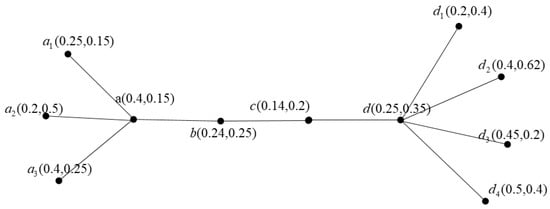
Figure 8.
Efficient domination of SIFG.

Table 1.
Vertex degree and edge degree membership values.
Every edge in the IFG (Figure 8) is strong, and the only efficiently dominating set is T = {a, d} since every vertex in V − T is dominated by exactly one vertex and this dominating set is unique. The construction of the sub-SIFN is different from the construction of SFN. As the intuitionistic fuzzy network for every node and edge has membership values, let the efficiently dominating nodes (EDNs) be o1, o2, o3, o4, …, or. These nodes are the center of the subnetworks, namely say SIFN1, SIFN2, SIFN3, SIFN4, …, and SIFN5, respectively. Let the neighbors of o1, o2, o3, o4, …, or be ; ; , …, , respectively. First, the SIF subnetwork is SIFN1, whose center is o1 and its neighbors are . The first subdivision value . Set (where is the numerical value 1 followed by the number of 0 digits of an integral part of V1) partitioned into the sum of l1 values, say , respectively, and assign these values minimum values of either o1 or , as degree of truth membership values. Likewise, the frame of the r th subnetwork continues, which is SIFNr. The SIF subnetwork 1 and the rth networks are shown in Figure 9 and Figure 10, respectively.
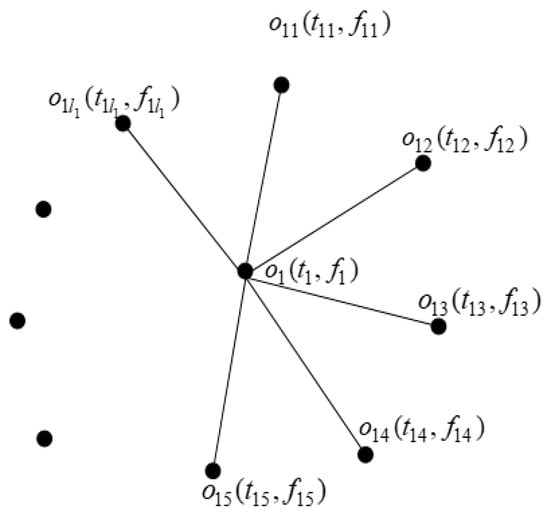
Figure 9.
SIF subnetwork-1.
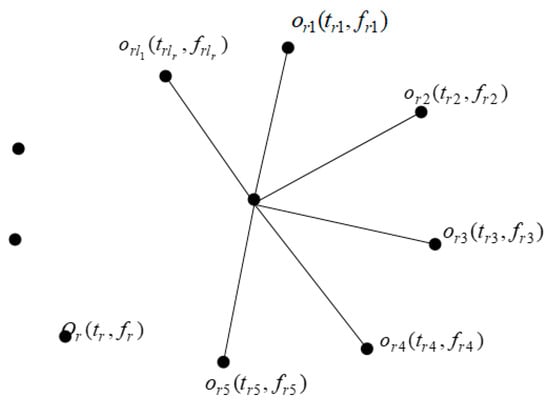
Figure 10.
SIF r-th subnetwork.
The encrypted SIFN with a minimum number of edges and a moderate number of edges is shown in Figure 11 and Figure 12, respectively. The rest of the framework of SIFN is similar to SFN. One of the illustrations is given as follows.
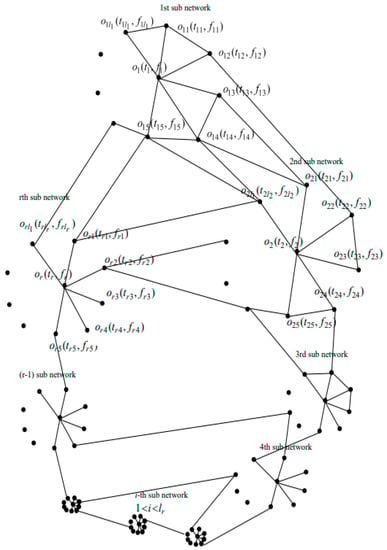
Figure 11.
Encrypted SIFN with more than moderate edges.
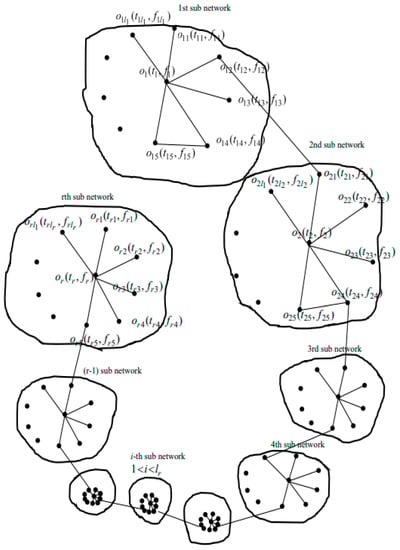
Figure 12.
Encrypted SIF network with minimum edges.
5.6. Illustration
The secret number is . The encrypted SIFN with the secret number is shown in Figure 13. The edge membership values are given in the following Table 2.
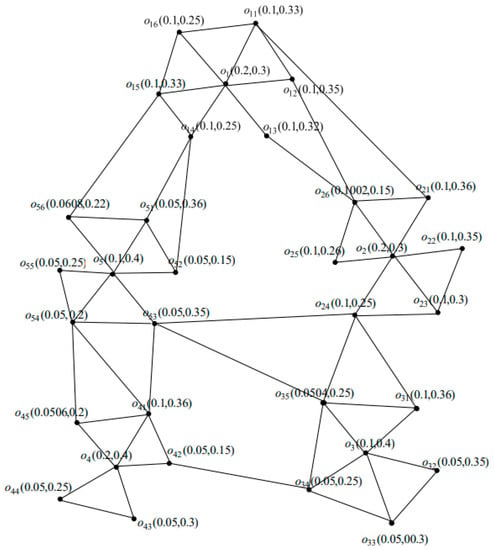
Figure 13.
Illustration of the encrypted SIFN with the secret number—10,810.

Table 2.
Degree of edge membership values in Figure 13.
6. Real-Time Applications
In this section, we present several real-world scenarios where the application of our fuzzy network using efficient domination can be beneficial. By illustrating the practical relevance of our proposed system, we aim to demonstrate its value and applicability in various domains.
6.1. Telecommunications Networks
The proposed system can be employed to optimize the structure of telecommunication networks, minimize latency and reduce the costs associated with infrastructure deployment and maintenance [25]. By identifying the efficiently dominating nodes within the network, our approach can help design networks with improved connectivity, fault tolerance, and resource allocation [26]. For instance, the placement of cell towers or routers can be optimized to ensure the maximum coverage with the minimum number of links. This will reduce the overall cost of establishing and maintaining the network [27,28].
6.2. Transportation Systems
Our approach can be applied to optimize transportation networks, such as road networks or public transit systems. By efficiently connecting critical points (e.g., hubs, stations), using the minimum number of links, our proposed system can result in reduced travel times, lower infrastructure costs, and enhanced traffic flow. In the context of public transit systems, efficient domination can be used to determine the optimal location and connections of stations, minimizing the number of transfers required for passengers and improving the overall efficiency of the system [29,30].
6.3. Social Network Analysis
The proposed system can be applied to analyze social networks to identify influential nodes, optimize information dissemination, and improve community detection. By employing efficient domination, our approach can help in understanding the structure and dynamics of social networks, enabling researchers and practitioners to develop more effective strategies for information diffusion, marketing, or public health interventions [31,32].
7. Conclusions
We delivered the combinatorial technique to find the secret number, which has been presented in the constructed strong fuzzy network. Constructing the strong fuzzy network plays an important role in the network due to the concept of efficient domination. The efficiently dominating members are certain nodes of the dominating set such that every vertex that is not in the dominating set is adjacent to exactly one vertex of the dominating member. The secret key is to identify the most efficient and dominant set of SFN. The network becomes more complicated to decrypt as we assign the repeated values of dij and the maximum number of edges present in the constructed SFN. Furthermore, the efficiently dominating set of the constructed network is unique. Moreover, we developed the intuitionistic fuzzy network, and an illustration was given that provides a better understanding of encryption and decryption using efficient domination.
Author Contributions
Conceptualization, N.K., A.M., M.M. and J.U.P.; Data curation, N.K., A.M. and J.U.P.; Formal analysis, N.K. and A.M.; Investigation, N.K. and A.M.; Methodology, N.K., A.M., M.M. and J.U.P.; Supervision, M.M. and R.G.; Visualization, N.K., A.M., M.M. and J.U.P.; Writing—original draft, N.K., A.M. and J.U.P.; Writing—review and editing, M.M. and R.G. All authors have read and agreed to the published version of the manuscript.
Funding
This work was supported by the project SP2023/074 Application of Machine and Process Control Advanced Methods supported by the Ministry of Education, Youth and Sports, Czech Republic.
Data Availability Statement
The data availability of this research work is based on the published research article of the relevant topics.
Conflicts of Interest
The authors declare no conflict of interest.
References
- Zadeh, L.A. Fuzzy Sets. Inf. Control 1965, 8, 338–353. [Google Scholar] [CrossRef]
- Bondy, J.A.; Murthy, U.S.R. Graph Theory with Applications; American Elsevier Publishing Co., Ltd.: New York, NY, USA, 1976. [Google Scholar]
- Ore, O. Theory of Graphs; American Mathematical Society: Providence, RI, USA, 1962. [Google Scholar]
- Haynes, W.T.; Slater, J.P. Paired-Domination in Graphs. Networks 1998, 32, 199–206. [Google Scholar] [CrossRef]
- Biggs, N. Perfect Codes in Graphs. J. Comb. Theory Ser. B 1973, 15, 289–296. [Google Scholar] [CrossRef]
- Kulli, V.R. Theory of Domination in Graphs; Vishwa International Publications: Gulbarga, India, 2012. [Google Scholar]
- Kulli, V.R.; Janakiram, B. The Split Domination Number of a Graph. N. Y. Acad. Sci. 1997, 32, 16–19. [Google Scholar]
- Kulli, V.R.; Patwari, D.K. Total Efficient Domination in Graphs. Int. Res. J. Pure Algebra 2016, 6, 227–232. [Google Scholar]
- Cockayne, E.J.; Hedetniemi, S.T. Towards a Theory of Domination in Graphs. Networks 1977, 7, 247–261. [Google Scholar] [CrossRef]
- Swaminathan, V.; Dharmalingam, K.M. Degree Equitable Domination on Graphs. Kragujev. J. Math. 2011, 31, 191–197. [Google Scholar]
- Meenakshi, A.; Baskar, B.J. Paired Equitable Domination in Graphs. Int. J. Pure Appl. Math. 2016, 109, 75–81. [Google Scholar]
- Meenakshi, A. Equitable Domination in Inflated Graphs and Its Complements. AIP Conf. Proc. 2020, 2277, 100006. [Google Scholar]
- Kwon, Y.S.; Lee, J.; Sohn, M.Y. Classification of Efficient Dominating Sets of Circulant Graphs of Degree 5. Graphs Comb. 2022, 38, 120. [Google Scholar] [CrossRef]
- Somasundram, A.; Somasundram, S. Domination in Fuzzy Graphs-I. Pattern Recognit. Lett. 1998, 19, 787–791. [Google Scholar] [CrossRef]
- Nagoorgani, A.; Chandrsekaran, V.T. Domination in Fuzzy Graph. Adv. Fuzzy Sets Syst. 2006, 1, 17–26. [Google Scholar]
- Enriquez, E.; Grace, E. Domination in Fuzzy Directed Graphs. Mathematics 2021, 9, 2143. [Google Scholar] [CrossRef]
- Atanassov, K.T. Intuitionistic Fuzzy Sets. Int. J. Bioautomation 1999, 20, 1–6. [Google Scholar]
- Karunambigai, M.G.; Parvathi, R.; Bhuvaneswari, R. Constant Intuitionistic Fuzzy Graphs. NIFS 2011, 17, 37–47. [Google Scholar]
- Shannon, A.; Atanassov, K. On a Generalization of Intutionistic Fuzzy Graphs. NIFS 2006, 12, 24–29. [Google Scholar]
- Nagoor, G.A.; Shajitha, B.S. Degree, Order and Size in Intuitionistic Fuzzy Graphs. Comput. Math. 2010, 3, 11–16. [Google Scholar]
- Nagoor, G.A.; Anupriya, S. Split Domination in Intuitionistic Fuzzy Graph. Adv. Comput. Math. Its Appl. 2012, 2, 278–284. [Google Scholar]
- Mullai, M.; Broumi, S.; Jeya, B.R.; Meenakshi, R. Split Domination in Neutrosophic Graphs. Neutrosophic Sets Syst. 2021, 47, 240–249. [Google Scholar]
- Meenakshi, A.; Baskar, B.J. Encryption through Labeling Using Efficient Domination. Asian J. Res. Soc. Sci. Humanit. 2016, 6, 1967. [Google Scholar] [CrossRef]
- Meenakshi, A.; Senbagamalar, J.; Neel, A.A. Encryption Using Graph Networks. In Proceedings of the 2nd International Conference on Mathematical Modeling and Computational Science, ICMMCS, Gandhinagar, India, 12 December 2021; Part of Book Series of Advances in Intelligent Systems and Computing (AICS). Springer: Singapore, 2021; Volume 1422, pp. 123–130. [Google Scholar]
- Cao, K.; Wang, B.; Ding, H.; Lv, L.; Dong, R.; Cheng, T.; Gong, F. Improving Physical Layer Security of Uplink NOMA via Energy Harvesting Jammers. IEEE Trans. Inf. Forensics Secur. 2021, 16, 786–799. [Google Scholar] [CrossRef]
- Song, J.; Mingotti, A.; Zhang, J.; Peretto, L.; Wen, H. Accurate Damping Factor and Frequency Estimation for Damped Real-Valued Sinusoidal Signals. IEEE Trans. Instrum. Meas. 2022, 71, 1–4. [Google Scholar] [CrossRef]
- Li, Q.; Lin, H.; Tan, X.; Du, S. H∞ Consensus for Multiagent-Based Supply Chain Systems Under Switching Topology and Uncertain Demands. IEEE Trans. Syst. Man Cybern. Syst. 2020, 50, 4905–4918. [Google Scholar] [CrossRef]
- Lu, S.; Ban, Y.; Zhang, X.; Yang, B.; Liu, S.; Yin, L.; Zheng, W. Adaptive control of time delay teleoperation system with uncertain dynamics. Front. Neurorobot. 2022, 16, 152. [Google Scholar] [CrossRef] [PubMed]
- Hou, X.; Zhang, L.; Su, Y.; Gao, G.; Liu, Y.; Na, Z.; Xu, Q.; Ding, T.; Xiao, L.; Li, L.; et al. A space crawling robotic bio-paw (SCRBP) enabled by triboelectric sensors for surface identification. Nano. Energy 2023, 105, 108013. [Google Scholar] [CrossRef]
- Wu, Y.; Sheng, H.; Zhang, Y.; Wang, S.; Xiong, Z.; Ke, W. Hybrid Motion Model for Multiple Object Tracking in Mobile Devices. IEEE Internet Things J. 2022, 10. [Google Scholar] [CrossRef]
- Zenggang, X.; Mingyang, Z.; Xuemin, Z.; Sanyuan, Z.; Fang, X.; Xiaochao, Z.; Yunyun, W.; Xiang, L. Social Similarity Routing Algorithm based on Socially Aware Networks in the Big Data Environment. J. Signal Process. Syst. 2022, 94, 1253–1267. [Google Scholar] [CrossRef]
- Ni, Q.; Guo, J.; Wu, W.; Wang, H. Influence-Based Community Partition with Sandwich Method for Social Networks. IEEE Trans. Comput. Soc. Syst. 2022, 1–12. [Google Scholar] [CrossRef]
Disclaimer/Publisher’s Note: The statements, opinions and data contained in all publications are solely those of the individual author(s) and contributor(s) and not of MDPI and/or the editor(s). MDPI and/or the editor(s) disclaim responsibility for any injury to people or property resulting from any ideas, methods, instructions or products referred to in the content. |
© 2023 by the authors. Licensee MDPI, Basel, Switzerland. This article is an open access article distributed under the terms and conditions of the Creative Commons Attribution (CC BY) license (https://creativecommons.org/licenses/by/4.0/).